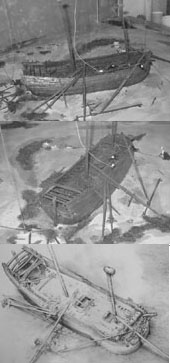09.18.2007 17:19
 By Ali Nassor
By Ali Nassor
Special to The St. Petersburg Times
St. Petersburg archeologists earlier this month discovered the wreck of a class of ship used in the exploration of the Antarctic in the early 19th century. The shipwreck was found lying in differing depths of between 19 and 29 meters on the seabed of the Gulf of Finland.
The discovery of the wreckage of the Svir, a sister vessel to the famous Mirny frigate, the first to reach the Antarctic coast in 1820, refutes the two-century-old hypothesis reached by marine researchers and historians that the sunken ship was swept to deeper seas away from the Gulf as a result of a storm in October 1824.
“In fact the vessel went straight to the sea bottom immediately after it was hit by the storm, providing limited time for the 115-member crew to abandon ship,” said Andrei Lukoshkov, who led a six-man team of scholars and divers in a 12-day archeological expedition to the Gulf of Finland.
The sailors swam to a neighboring islet to be rescued by local fishermen a few days latter. Though the Olymp frigate was sent in a rescue mission following news of the Svir’s disappearance about two weeks later, the fate of the Svir became the subject of mysterious speculation until its discovery this month, said Lukoshkov.
The find also serves as an eye-opener to the detailed secrets of the technology of the ships sent to the Antarctic, according to Lukoshkov.
“There’s scant record of shipbuilding technology regarding this class of ship, although both ships were built at the River Svir’s Lodeyny Pol wharf near Lake Ladoga,” he said, adding that “a preliminary study of the remnants has revealed a very limited degree of foreign technology in designing the ship.”
Meanwhile, the archeologists are lobbying for finances to rebuild the Svir to serve as a monument to the history of geographical discoveries by the Russian Navy of the early 19th century.
However, Ilya Kochorov, a film producer with the team is pessimistic about plans to raise the ship without financial backing from the Russian Central Navy Museum, “an organization,” he said “run by military bureaucrats who have no time for history and related sciences.”
Negotiations are underway to launch a department of marine archeology at the St. Petersburg State University’s Faculty of History, he said.
The recent breakthrough Lukoshkov’s team is the twentieth warship wreck discovered since the “Secrets of the Sunken Ships” project aimed at discovering and studying, among others, the 19th century Russian Imperial Fleet was launched four years ago.
Other warships on the list include the Gangut, built in 1892, the Oleg frigate that was sent on its maiden voyage in 1860 and the Jigit and Naezdnik boats, both built in 1856.
Lukoshkov and his team have also discovered a total of 39 wrecks including merchant and passenger ships in the Gulf of Finland, River Volkhov and Lake Ladoga in the past four years.
During their latest mission this year, they discovered nine ship wrecks of varying periods and classes, from the Dutch merchant ships of the 17th century to a Finnish patrol boat sunk in 1944.
www.baltic-sunken-ships.ru
News source: times.spb.ru
 Print this news Print this news
City news archive for 18 September' 2007.
City news archive for September' 2007.
City news archive for 2007 year.
|